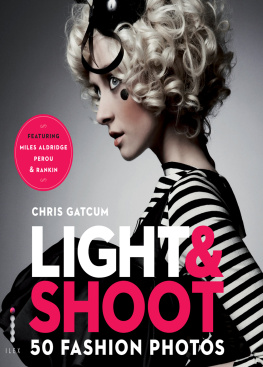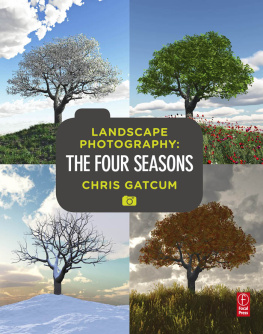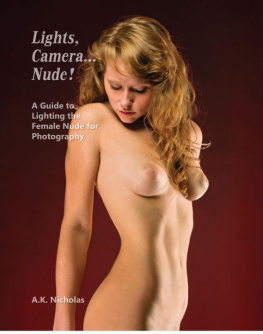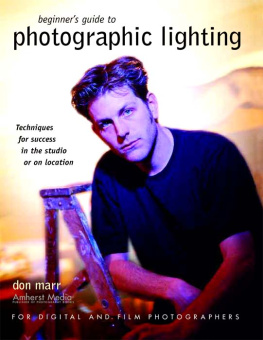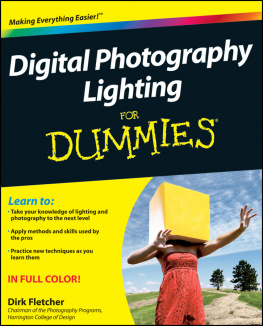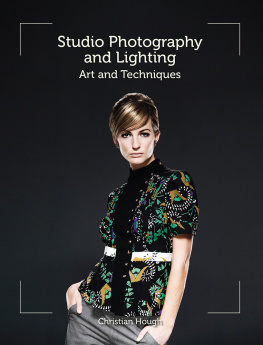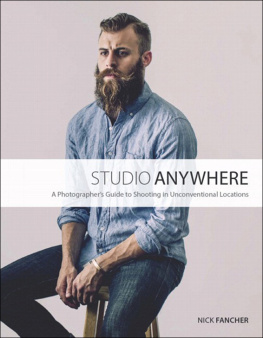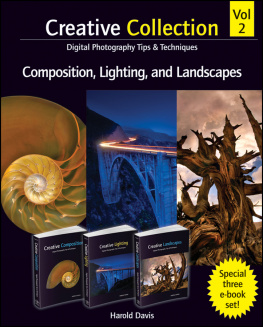LIGHT &
SHOOT


CHRIS GATCUM
Light &
SHOOT
50 FASHION PHOTOS
ILEX
First published in the UK in 2011 by
ILEX
210 High Street
Lewes
East Sussex
BN7 2NS
www.ilex-press.com
Copyright 2011 The Ilex Press Limited
Publisher: Alastair Campbell
Creative Director: Peter Bridgewater
Associate Publisher: Adam Juniper
Managing Editor: Natalia Price-Cabrera
Editorial Assistant: Tara Gallagher
Art Director: James Hollywell
Design: JC Lanaway
3D Illustrations: Nicholas Rowland
Colour Origination: Ivy Press Reprographics
Any copy of this book issued by the publisher is sold subject to the condition that it shall not by way of trade or otherwise be lent, resold, hired out or otherwise circulated without the publishers prior consent in any form of binding or cover other than that in which it is published and without a similar condition including these words being imposed on a subsequent purchaser.
British Library Cataloguing-in-Publication Data
A catalogue record for this book is available from the British Library.
ISBN: 978-1-907579-73-8 (This Edition)
ISBN: 978-1-907579-14-1 (Print Edition)
All rights reserved. No part of this publication may be reproduced or used in any form, or by any means graphic, electronic or mechanical, including photocopying, recording or information storage-and-retrieval systems without the prior permission of the publisher.
Printed and bound in China.
10 9 8 7 6 5 4 3 2 1

Contents
Of all the genres of photography, fashion is arguably the most challenging, and certainly one of the most competitive. Yet despite this, if you go to any formal, general photography course, fashion will be, more often than not, the subject that most students want to specialize in. Whether this is based on dreams of fame and fortune from what can be an exceptionally lucrative career, or the associated glamour of photographing beautiful men and women dressed by celebrated designers, it seems that the majority of young photographers want to shoot fashion.
And who can blame them? Like fashion itself, the photography that surrounds it is fast-paced and excitingconstantly evolving and redefining itself, and inherently more open to experimentation and personal expression than many other genres. Its easy to think that fashion photography is simply about photographing someone in clothes, similar to portraiture, but it is much more than that, and requires a truly multi-disciplinary approach to do it well. Outdoors on location, for example, you may well need the craft of a landscape photographer if you want to make the most of the location and the light, or the techniques and responses of a photojournalist if youre aiming to imbue your shots with a naturalistic, documentary style. At the same time, indoor location shoots can involve elements of interior photography and even architecture, while studio-based fashion can demand still-life and advertising photography skills, regardless of whether its a relatively straight shot against a plain backdrop, or a scratch-built set in which you place your subject.
On top of all this, you need to borrow heavily from the portrait photographers toolbox to fully appreciate how to light people, and to be truly successful, you need to be equally confident in all of these areas if you want your work to be as versatileand as commercialas possible. With so many skills required, its perhaps unsurprising that for every aspiring photographer who transforms their passion into a career, many more who set out on a fashion-based path do not make it. This isnt to say you should give up before you begin (if why bother is your immediate reaction, then fashion photography isnt for you), but dreams and desires need to be tempered with reality: fashion photography takes commitment, determination, and no small amount of talent. It certainly isnt an easy option.
What follows in this book is an inspirational and practical guide to shooting fashion in a wide range of styles and settings, with the emphasis on the use of lighting, rather than digital processing, to create a specific look or feel. Some of the images you will love, while others you may not be quite so keen on, but what they all have is a sparka certain something that should serve to inspire you and your work, be it the pose, the approach to post-processing, or the lighting. With that in mind, you certainly shouldnt approach this book as a set of blueprints to creating definitive fashion shots, but instead treat it as a guide to techniques that can be borrowed, adapted, and repurposed for your own work. Make the shots your own and, from there, who knows where your fashion photography will take you.

Without light there wouldnt be photography. Period. It doesnt matter whether youre shooting a landscape, a still life, or a portrait, all photographs need light in order to make an exposure. That clearly makes lighting a fundamental part of the photographic equation, and its even more critical in fashion photography: not because there are conventions that need to be followed, or rules that need to be adhered to if you want to take a good shot, but the exact opposite. In fashion, there is no right or wrong.
Because there are no set guidelines, fashion photography is much more open to experimentation than most genres, and as youll see when you look at the 50 stunning images in the following chapters, anything and everything goes when it comes to lighting a fashion shot. From shots taken outdoors with just the sun for company, through to elaborate multi-light setups, the only thing that ultimately counts in each of these shots is the result. Yet whether a picture is taken using flash, daylight, or something else altogether in the case of Marcelo Nuness black light image, on , that core fact remains: without light there wouldnt be photography. So lets take a look at the options to get you started.
Without a doubt, flash is the most widely used type of artificial lighting for fashion shots, so much so that for many photographers its impossible to comprehend shooting without it. There are many reasons for its popularity, including its cool running temperature and the brief burst of motion-freezing light, but the most important aspect from a creative perspective is the versatility and controllability that comes in part from the many and varied lighting modifiers that are available.
FLASHES, OR STROBES, come in a wide range of shapes, sizes, and even colors, and with the exception of the cheapest unbranded units they can be fitted with a bewildering array of accessories that shape and modify their output. From giant softboxes and umbrellas that create a soft, diffuse light, through to snoots and spot attachments that can limit the light to a diminutive, hard-edged pool with pinpoint accuracy, flash has it all. But with so much choice, its not always easy to know where to start, especially when competing manufacturers all claim superiority in one area or another.

